'Eight suggested methods for raising the obelisk'
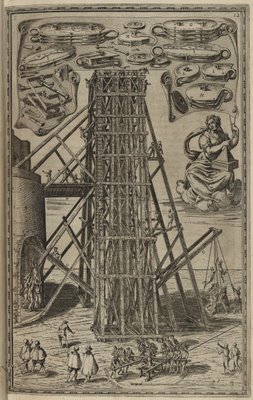
'Descrittione della forma del castello fatto per alzare la guglia'
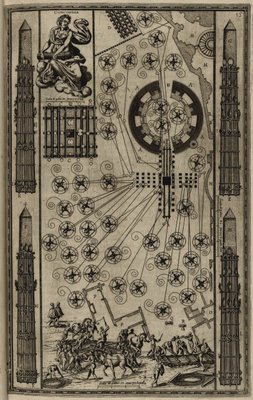
'La pianta, e compartimento di tutti gli argani
con tutte le preparationi fatte per calar la guglia'
con tutte le preparationi fatte per calar la guglia'
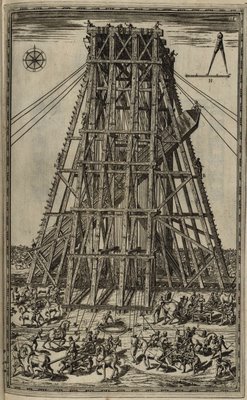
'La gvglia dentro al castello, nel modo che stava mentre calaua à basso'
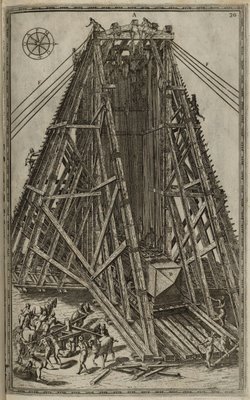
'La gvglia per la punta, subito che fu colcata sopra lo
strascino, con tvtte le corde, che la sostentavano dentro al
castello fermato con ventole da tramontana, e ostro.'
strascino, con tvtte le corde, che la sostentavano dentro al
castello fermato con ventole da tramontana, e ostro.'
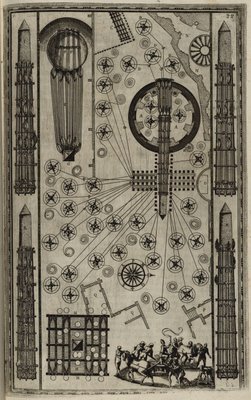
'La pianta, e compartimento di tutti gli argani con tutte le
preparationi fatte per calar la gvglia, come s'è detto di sopra'
preparationi fatte per calar la gvglia, come s'è detto di sopra'

'Douendosi condur la guglia da questo lugo, sino su a la piazza
San Pietro per distanza di canne cento quindici, e iui drizzarla..'
San Pietro per distanza di canne cento quindici, e iui drizzarla..'
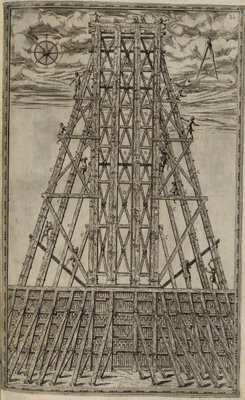
'Monte armato a torno il castello, che gli sorgeva sopra per drizzar la guglia..'
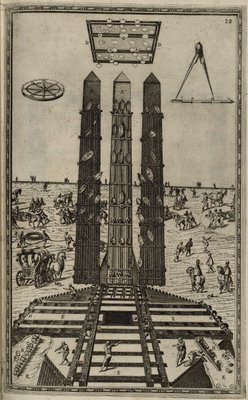
'Tre guglie in piedi per poter mostrare in vna vista
l'attaccatura delle traglie in tutte tre le facie sudette'
l'attaccatura delle traglie in tutte tre le facie sudette'
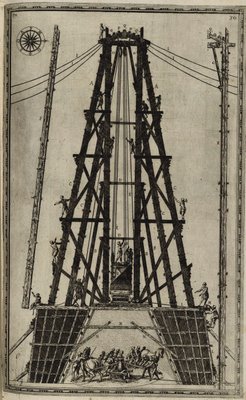
'Il castello aperto in faccia, con la pvnta della gvglia
tiratavi dentro, e i canapi, che la sostentauano.'
tiratavi dentro, e i canapi, che la sostentauano.'
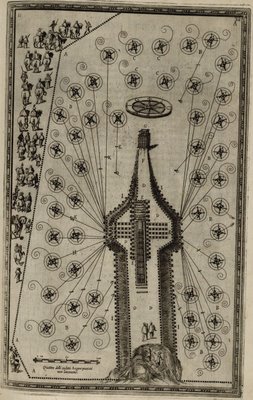
'Della trasportatione dell'obelisco vaticano et delle
fabriche di nostro signore papa Sisto V fatte dal cavallier
Domenico Fontana, architetto di Sva Santita, libro primo.'
fabriche di nostro signore papa Sisto V fatte dal cavallier
Domenico Fontana, architetto di Sva Santita, libro primo.'
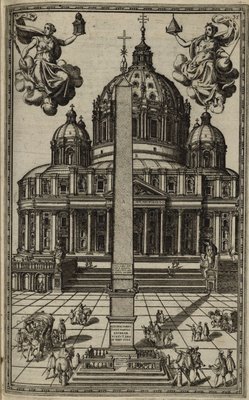
Guglia con i suoi adornamenti posta nel mezo della piazza;
Fabrica della chiesa di San Pietro nel modo, che starà, quando sarà finita..'
Fabrica della chiesa di San Pietro nel modo, che starà, quando sarà finita..'

'Il palazzo fatto nella vigna di nostro signore mentre era cardinale.'

'La Capella del Presepio.'
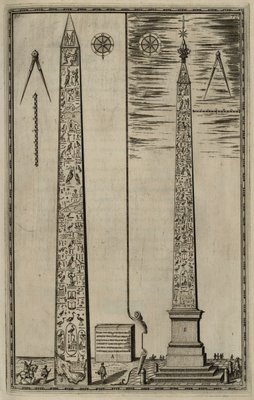
'Il grand'obelisco di Costantio a S. Giouanni Laterano.'
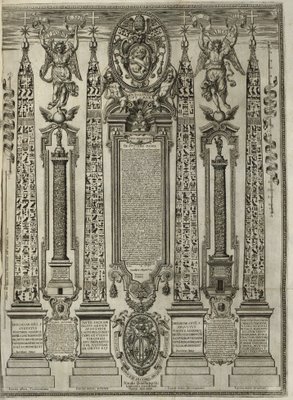
'La gvglia della Madonna del Populo - faccia uerso tramontana,
faccia uerso oriente, faccia uerso mezzogiorno, faccia uerso occidente;
Colonna Antonnia ; Colonna Traiana'
faccia uerso oriente, faccia uerso mezzogiorno, faccia uerso occidente;
Colonna Antonnia ; Colonna Traiana'
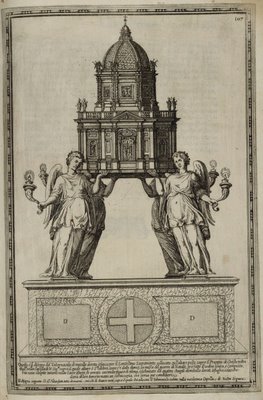
'Questo è il disegno del tabernacolo di metallo dorato à fuoco
per il Santissimo Sacramento collocato su l'altare posto sopra
il Presepio di Christo nostro Red.re. nella capella di N. Sig.re...'
per il Santissimo Sacramento collocato su l'altare posto sopra
il Presepio di Christo nostro Red.re. nella capella di N. Sig.re...'
An 83 feet tall, 320 ton granite obelisk was brought by Caligula from Alexandria in Egypt to Rome aboard the largest ship ever built in ~37AD. It is reported that the ship - a barge - was later sunk on purpose to provide a foundation for a quay in the port of Ostia.
The obelisk - which folklore alleges contained the ashes of Julius Caesar in its metal crowning orb - was somehow erected by Caligula in the famed Circus Maximus.
During the renaissance, long after the Circus Maximus arena had disappeared, the monumental St Peters Basilica construction project, headed by Michelangelo and Giacomo Della Porta, was undertaken at the direction of a number of Popes. The idea of moving the obelisk a quarter of a mile to a place in front of the basilica was raised on several occasions but even Michelangelo declined to believe it was feasible.
Pope Sixtus V was insistent however, and in 1585 invited engineering proposals for carrying out the move. He was apparently persuaded to accept the submission of Domenico Fontana (one of the architectural engineers working under Della Porta) when a model of the engineering system allowed Sixtus to turn winches and successfully move the miniature version of the obelisk himself.
Fontana's project didn't introduce any new engineering techniques but the size and nature of the problem ensured it would be remembered as one of the most amazing technological feats of the 16th century. Reports vary but it seems the move took around 12 months in total to complete; half of the time being spent on scaffold construction and clearing buildings from the area. "The scaffold was operated with tuned precision by 900 men and 74 horses, harmoniously arranged amidst a myriad of pulleys, levers, and capstans".
The obelisk was exorcised, the (ashless, as Fontana advises) orb was replaced by a christian cross and it was erected at its present location on September 14, 1586 before a large crowd who were silenced by the Swiss guard.
- Domenico Fontana published 'Della Trasportatione dell’Obelisco Vaticano et delle Fabriche di Nostro Signore Papa Sisto V', which includes a large number of detailed copperplate etchings by Natale Bonifacio, in 1590. There are a few copies online. I chose to snag images from the copy online at the Portuguese National Library because they are by far the largest versions. I brightened all the above images slightly. It's perhaps personal taste as to whether that style of image is better or worse aesthetically speaking than the collection of illustrations available at NYPL (thumbnails). But NYPL is the quickest and easiest way to view all the illustrations [all of the image captions above were copied from NYPL] Octavo also has the complete book available and you can just about read the text if you squint.
- The Saint Peters Basilica site has an extensive history section.
- 'A Forest of Obelisks' by Paul Lunde at Saudi Aramco World.
- 'Obelisci' from Bill Sayer's site.
- Domenico Fontana at the Catholic Encyclopedia.
- The short quote above comes from an extensive but thoroughly interesting Masters thesis by Eric Solomon Toker from 1998 entitled: 'An Architectural Excursis into the Site of Becoming: Domenico Fontana's Della Trasportatione dell'Obelisco Vaticano'. It also includes an english translation of the first chapter as an appendix - an english version was never produced - which is an obsequious yet self praising slab of amusing text. The catch? It is an 8.5 Mb pdf document. [via Facetation]
- Although slightly tangential, 'Kircher's Obelisks' is very interesting.
- 'How obelisks got where they are now' (excerpt) from the Newcomen Society.
- 'Obelisks' from a site at Australian National University.
- 'Moving an Obelisk' or 'Moving the Vatican Obelisk' - for quick versions.



6 comments :
There's a great story about this obelisk. According to legend, in order to ensure the workers would not be distracted, the Pope ordered that anyone who spoke while the obelisk was being moved would be put to death. As the obelisk was being raised, the friction caused the ropes to begin to smolder, but no one would utter a word. Finally, one brave man yelled "Fetch water! The ropes are burning!" The obelisk was saved and as a reward, the Pope decreed that the man would have the honor of serving Mass for the Pope on Ash Wednesday. The last living direct descendent of the man (reportedly), serves Ash Wednesday mass for the Pope to this day.
Thanks for that. Good story indeed!
Such a great read.
Thanks!!
Great find. Fontana's work is quite remarkable. Edmund Halley (of comet fame) owned a copy and there's also a copy with annotations in Galileo's hand. Most researchers are familiar only with Dibner's "Moving the Obelisks", which reprints Fontana's plates. Bern Dibner was a succesful engineer and ambitious book collector. His collection became the core of both the Dibner Library for the History of the Science and Technology and the Burndy Library, currently being moved from MIT to the Huntington Library.
Fontana himself hailed from Melide on Lake Lugano. He was only 12 years younger than the military engineer Agostino Ramelli, who also hails from the shores of Lake Lugano. I can only imagine that they were somehow acquainted!
Cheers George: I had read your musing about Ramelli/Fontana on Facetation. A bit of wishful thinking?
I'd not seen Dibner mentioned at all but I only skimmed much of that Masters thesis.
There's another version around from 100 years after Fontana's book. Glazer Gallery have some images by Alessandro Specchi but it's difficult to see what changes might have been made to the original etchings. {I see mention that Specchi was a student of Fontana but that seems pretty unlikely, Specchi being born in 1668 - maybe 'student of his style'}
I would have thought that sort of 'reconditioning' of an engineering publication would be your stock in trade George, n'est-ce pas?
Tony,
I too loved the burning ropes story . But I just read in Robert Hughes ' "rome" that it's apocryphal as Fontana makes no mention of it nor does anyone else at the time. See page 254. Anyway, cool, huh. Hauling the thng I mean. Making it? Jesus! You know?
Post a Comment
Comments are all moderated so don't waste your time spamming: they will never show up.
If you include ANY links that aren't pertinent to the blog post or discussion they will be deleted and a rash will break out in your underwear.
Also: please play the ball and not the person.
Note: only a member of this blog may post a comment.